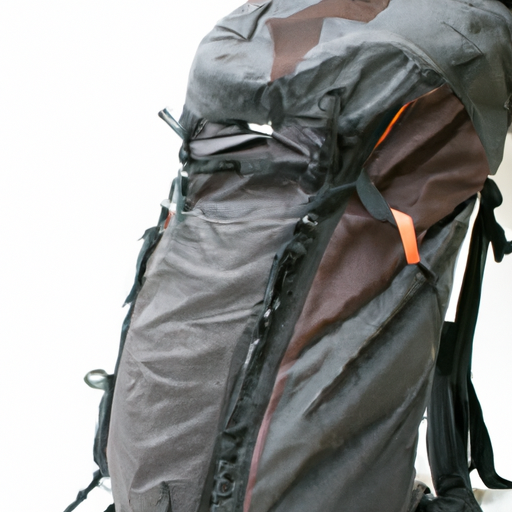How To Get Into Backpacking
If you’ve ever been captivated by the idea of exploring the great outdoors with just a backpack for company, then this article is for you. Discover how to embark on a thrilling journey into the world of backpacking, whether you’re a complete beginner or an experienced hiker looking to expand your horizons. With practical tips and advice, this guide will equip you with everything you need to know to get started and make the most of your unforgettable adventures in the wilderness. So grab your backpack, lace up your boots, and prepare for an exhilarating journey that will reconnect you with nature like never before.
Choose the Right Gear
Research the Essentials
When starting your backpacking journey, it’s crucial to research the essential gear you’ll need to ensure a smooth and enjoyable experience. Look into backpacks, sleeping bags, tents, cooking equipment, and other necessary items. Take note of the features that are important to you and compare different brands and models. This research will help you make informed decisions when purchasing your gear.
Invest in Good Quality Gear
While it can be tempting to opt for budget-friendly options, investing in good quality gear will go a long way in terms of durability and comfort. High-quality gear is designed to withstand the elements, ensuring that your equipment will last for many adventures to come. This investment will prevent you from having to replace your gear too frequently, ultimately saving you money in the long run.
Consider Weight and Comfort
When selecting your gear, consider both weight and comfort. A heavy backpack can quickly become a burden on your shoulders, especially during long hikes. Look for lightweight options without compromising on quality. Additionally, choose gear that is comfortable to wear or use for extended periods. Comfortable gear can make a significant difference in how enjoyable your backpacking trips will be.
Pack Smartly
Packing smartly is essential to ensure that you have everything you need without carrying excessive weight. Create a checklist of the essential items you’ll require, including clothing, food, water, and safety supplies. Prioritize items based on their importance and consider multi-purpose gear that can serve multiple functions. Practice your packing skills to maximize space and weight distribution in your backpack.
Physical Preparation
Build Endurance and Strength
Backpacking involves long hours of walking over varied terrains with a heavy pack on your back. To prepare your body for this physical challenge, it’s crucial to build endurance and strength. Engage in regular cardiovascular exercises such as hiking, running, or cycling to improve your stamina. Additionally, incorporate strength training exercises targeting your legs, core, and back muscles to enhance your overall strength and stability.
Start with Day Hikes
If you’re new to backpacking, start by embarking on day hikes to gradually acclimate your body to the demands of longer treks. Day hikes provide an opportunity to test your gear, assess your fitness level, and get comfortable with the basics of hiking. Gradually increase the distance and difficulty of your hikes to push your limits while still maintaining a manageable pace.
Increase Distance and Difficulty
As you gain more experience and confidence, gradually increase the distance and difficulty of your backpacking trips. Challenge yourself by tackling longer trails or venturing into more challenging terrain. This progressive approach will help you avoid overexertion and injuries while allowing you to gradually improve your physical capabilities.
Train with a Loaded Pack
To simulate the conditions of a backpacking trip, incorporate training sessions where you hike with a loaded pack. Start with a lighter load and gradually increase the weight as your body becomes accustomed to the additional strain. This training will not only prepare you physically but also allow you to test and adjust your gear accordingly.
Learn Navigation Skills
Understand Topographic Maps
An essential skill for backpacking is the ability to read and understand topographic maps. These maps provide valuable information about elevations, terrain features, water sources, and more. Familiarize yourself with the symbols and markings on the map to accurately interpret the landscape and plan your routes.
Practice Using a Compass
In conjunction with topographic maps, learning how to use a compass is vital for effective navigation in the wilderness. Practice orientating the map with the compass and identifying your current location. Mastering compass navigation will ensure that you can confidently navigate even in areas without reliable GPS signals.
Learn to Use GPS Devices
While traditional map and compass skills are essential, it’s also beneficial to learn how to use GPS devices. These devices can provide real-time information about your location, elevation, and help track your progress. Familiarize yourself with the features and functions of your GPS device and practice using it alongside traditional navigation methods for added accuracy.
Familiarize with Landmarks
In addition to map and compass skills, familiarize yourself with the natural landmarks in the areas you plan to backpack. This knowledge will serve as additional reference points when navigating the trails. Study prominent peaks, rivers, and other distinct features that can help orient yourself in unfamiliar terrain.
Plan Your Trips
Choose Suitable Backpacking Destinations
When planning your backpacking trips, consider the suitability of the destinations for your skill level and interests. Start with well-established trails that are well-marked and have amenities such as campsites and water sources. As you gain more experience, you can gradually explore more remote and challenging areas.
Research and Obtain Permits
Many backpacking destinations require permits to access and camp in specific areas. Research the permit requirements for your chosen destinations well in advance and plan accordingly. Some permits may have limited availability, so it’s crucial to secure them early to avoid disappointment. Familiarize yourself with any camping restrictions or regulations imposed by the land management agencies or national parks.
Consider the Seasons
Different seasons offer varying trail conditions and weather patterns. Consider the seasons when planning your backpacking trips, as they can significantly impact your experience. Take into account factors such as temperature, precipitation, daylight hours, and insect activity. Plan your trips during seasons that align with your preferences and comfort level.
Create a Detailed Itinerary
Once you’ve chosen your destination, create a detailed itinerary for your backpacking trip. Outline the number of days you’ll be on the trail, the daily distances you intend to cover, and the camping spots or waypoints along the way. Share this itinerary with someone you trust, and inform them of your expected return date. This information is crucial for your safety in case of any emergencies or unexpected circumstances.
Food and Water
Calculate Your Caloric Needs
When backpacking, it’s essential to fuel your body adequately to maintain your energy levels throughout the trip. Calculate your caloric needs based on your body weight, activity level, and the duration of your backpacking adventure. Plan your meals to include a balanced mix of carbohydrates, proteins, and healthy fats to provide sustained energy and aid in muscle recovery.
Choose Lightweight and Nutritious Food
When it comes to backpacking meals, focus on selecting lightweight and nutrient-dense options. Opt for dehydrated or freeze-dried meals that are lightweight and easy to prepare. Pack foods that are high in protein, fiber, and healthy fats to keep you satisfied and energized. Minimize packaging and waste by repackaging your meals into reusable containers.
Plan for Water Sources
Water is essential for survival while backpacking, so it’s crucial to plan for reliable water sources along your route. Research the availability of water sources such as streams, lakes, or springs and plan your daily mileage accordingly. Take note of any dry sections and ensure you have enough water carrying capacity to sustain yourself between water sources.
Learn Water Treatment Methods
In the wilderness, water sources may not always be safe for consumption due to potential contaminants. Learn proper water treatment methods such as using water filters, purifying tablets, or boiling water to make it safe to drink. Practice these methods before your backpacking trip to ensure you are confident in effectively treating water in the field.
Safety Considerations
Check Weather Conditions
Before embarking on your backpacking trip, always check the weather conditions for your chosen destination. Sudden changes in weather can significantly impact your safety and comfort. Be prepared for varying temperatures, precipitation, and potential storms. Adjust your gear and clothing accordingly to ensure you stay warm and dry in adverse weather conditions.
Leave an Itinerary with Someone
Safety should be a top priority when backpacking, and leaving an itinerary with someone you trust is crucial. Provide them with information on your destination, expected routes, and estimated return dates. Instruct them to contact the appropriate authorities if you do not return as planned. This precaution will ensure that help can be efficiently dispatched in case of any emergencies.
Pack Essential First Aid Supplies
Accidents and injuries can happen even on the most well-planned backpacking trips. Pack a comprehensive first aid kit that includes essentials such as bandages, antiseptic ointment, pain medication, and blister treatment. Familiarize yourself with basic first aid procedures and have knowledge of any specific medical conditions or allergies within your group.
Learn Bear Safety and Wildlife Encounters
When backpacking in wilderness areas, it’s essential to be aware of potential wildlife encounters, particularly with bears. Research the specific wildlife species in your destination and learn the appropriate safety protocols. Understand how to properly store your food to minimize the risk of attracting wildlife and know-how to react in the event of an encounter.
Master the Wilderness Skills
Set Up and Break Down Camp
Knowing how to effectively set up and break down your campsite is essential for a successful backpacking trip. Practice pitching your tent, using the necessary guy lines and stakes to secure it in various terrains. Familiarize yourself with the process of selecting a suitable site and consider factors such as wind direction, proximity to water sources, and level ground.
Build a Fire and Understand Fire Regulations
Building a fire can provide warmth, light, and a means of cooking meals while backpacking. However, it’s crucial to understand and follow fire regulations in the areas you visit. Learn how to build a safe and efficient campfire using designated fire rings or fire pits if permitted. Always ensure the fire is fully extinguished before leaving your campsite.
Learn Proper Waste Disposal
Practicing proper waste disposal is essential to minimize your impact on the environment while backpacking. Pack out all your trash, including food scraps and hygiene products, to leave no trace behind. Familiarize yourself with the local regulations on human waste disposal and use designated toilets or follow Leave No Trace principles for proper waste disposal in the backcountry.
Practice Leave No Trace Principles
Leave No Trace principles are guidelines that promote responsible outdoor ethics and conservation. These principles include concepts such as disposing of waste properly, minimizing campfire impact, respecting wildlife, and staying on designated trails. By adhering to Leave No Trace principles, you can contribute to the preservation of the wilderness for future generations to enjoy.
Connect with Experienced Backpackers
Join Local Hiking Clubs or Groups
Joining local hiking clubs or groups can provide a wealth of knowledge and support for beginner backpackers. These communities often organize group hikes, workshops, and social events where you can learn from experienced backpackers. Engaging with fellow enthusiasts will also allow you to share experiences, exchange tips, and build lasting connections.
Attend Backpacking Workshops or Courses
Attending backpacking workshops or courses can be an excellent way to expand your knowledge and skills. Look for local outdoor education centers or organizations that offer these programs. These workshops often cover a wide range of topics, including gear selection, navigation, wilderness safety, and outdoor cooking, providing valuable insights and hands-on learning opportunities.
Participate in Group Backpacking Trips
Participating in group backpacking trips organized by experienced backpackers can be a fantastic way to gain practical experience. These trips provide a supportive environment where you can learn from experienced leaders and fellow participants. Group trips also allow you to explore new areas with the guidance and expertise of those who are familiar with the terrain.
Learn from Online Communities and Forums
The internet offers a vast array of online communities and forums where backpackers can connect and learn from one another. Joining these communities allows you to access valuable resources, ask questions, and share your experiences. Take advantage of these platforms to gain insights, seek advice, and engage in discussions with experienced backpackers from around the world.
Budgeting for Backpacking
Estimate Trip Costs
Backpacking trips can vary significantly in terms of cost, depending on various factors such as the destination, duration, and gear requirements. Estimate the expenses associated with transportation, permits, gear purchases or rentals, food, accommodation, and any additional activities or services. Creating a realistic budget will help you manage your finances effectively and ensure you can fully enjoy your backpacking experience.
Invest in Essential Gear and Equipment
Investing in essential gear and equipment is crucial for a successful backpacking trip. While it may require an upfront investment, purchasing high-quality gear designed for the demands of backpacking will save you money in the long run. Prioritize the key pieces of equipment such as a backpack, tent, sleeping bag, and footwear. Consider purchasing used gear or borrowing from friends to reduce costs.
Consider Shared Expenses
Sharing the costs of transportation, permits, and camping fees with fellow backpackers can significantly reduce your expenses. Consider joining forces with friends or finding travel companions through hiking clubs or online forums. Splitting the costs of shared resources, such as cooking equipment or navigation tools, can also help decrease individual expenses.
Save Money on Meals and Accommodation
Backpacking offers the opportunity to minimize costs by preparing your meals and sleeping in the great outdoors. Opt for lightweight and nutritious backpacking meals instead of eating at restaurants or purchasing pre-packaged meals. Consider camping or utilizing backcountry shelters instead of staying in hotels or lodges. These money-saving strategies will allow you to allocate your budget more efficiently.
Overcoming Challenges
Stay Positive and Embrace Uncertainties
Backpacking can present unexpected challenges, from inclement weather to physical exhaustion. It’s important to maintain a positive mindset and embrace the uncertainties that come with outdoor adventures. Remember that overcoming challenges is part of the backpacking experience and provides valuable opportunities for personal growth and resilience.
Push Beyond Your Comfort Zone
Backpacking is an excellent opportunity to push beyond your comfort zone and test your limits. Embrace the physical and mental challenges that come with hiking long distances, carrying a heavy pack, and navigating unfamiliar terrain. Pushing beyond your comfort zone will build your confidence, increase your capabilities, and open doors to new and rewarding experiences.
Learn from Mistakes and Adapt
Mistakes are inevitable when backpacking, especially for beginners. Instead of dwelling on these mistakes, view them as learning opportunities. Reflect on what went wrong, identify areas for improvement, and adapt your strategies for future trips. With every challenge or setback, you’ll gain valuable knowledge and experience that will make you a more skilled backpacker.
Develop Mental Resilience
Backpacking can push you to your physical and mental limits. It’s essential to develop mental resilience to overcome obstacles and stay motivated. Cultivate a positive mindset, practice mindfulness techniques, and draw inspiration from the beauty of nature. By focusing on the present moment and acknowledging the progress you’ve made, you’ll be better equipped to tackle any challenges that come your way.
In conclusion, getting into backpacking requires careful consideration of gear, physical preparation, navigation skills, trip planning, safety precautions, wilderness skills, and networking with experienced backpackers. By following these comprehensive steps and continually expanding your knowledge and skills, you’ll be well-prepared to embark on memorable backpacking adventures. Remember to always prioritize safety, respect the environment, and enjoy the incredible experiences that the backpacking lifestyle offers.




